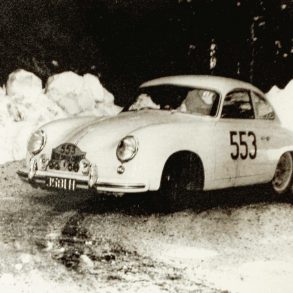Quintessential adjective
quin·tes·sen·tial | \ ˌkwin-tə-ˈsen(t)-shəl
:of the pure and essential essence of something
:of or relating to the most perfect embodiment of something
By the time the second world war came to an end, the quintessential sports car featured a long rectangular hood, suspended headlights, flowing separate fenders, a flat wooden dashboard and wire wheels. For motoring enthusiasts, the SS Jaguar, Morgan, or vintage MG fit that description perfectly. However, when post-war sports cars emerged in the early ’50s, the ideal sports car was not only radically different, every company had their own way of approaching it. But Porsche changed everything. It might not seem like it today, but when the 356 Speedster came to market, no one could imagine that an air-cooled, rear-engine, two-seater with little to no amenities would become the darling of enthusiasts, and become one of the most sought after collector cars of the 21st century, maybe even defined as the quintessential sports car of the modern era.

Although their humble and cost-conscious beginnings were the foundation of the Porsche brand—building their first cars on VW underpinnings—they quickly shaped their company into an uncompromised motorsports and production sports car leader. By the time Porsche was refining their 356 concepts, American distributor Max Hoffman asked Porsche to develop a sports car to compete against lower priced Triumphs and MGs. Porsche responded, building a car with only essential performance traits, minimal features, and critically important reliability. The resultant, and now iconic, Porsche Speedster continues to deliver performance and excitement decade after decade. Today, the remarkable 356 Speedster is still cited by historians, designers and motorsports journalists as one of the most influential sports cars of 20th century.
But what is it that makes the 356 such a continually engaging car, generation after generation? The answer is not one singular element, rather the way Porsche managed to deliver all key elements into a relaxed but precise car. Designed with body features from their earliest aerodynamic experiments, these cars were neither fast nor refined. They made unfamiliar engine sounds, were often hard to shift, and required completely different thinking when driving. But they were engaging and compelling sporting appliances with just the right amount of style for enthusiasts who wanted more driving thrills. Though the “inverted bathtub” moniker journalists gave to the 356 somewhat mocked the body design, there was nothing like it on the market that could capture your attention the way the Speedster did. The charming hood-cut smile, the perky headlight eyes, and the lack of a mouth (grille), gave the spunky little 356 a smug but unassuming confidence. And while consumers appreciated the 30 mpg fuel economy (even when gas was just 20 cents a gallon), the miserly fuel consumption was a key advantage contributing to many Porsche road race victories.

But it wasn’t just the performance the 356 offered. The Speedster did all the things you’d want a sports car to do on undeveloped roads, adventuring in cold or warm climates, without leaving you stranded (Doc Hollywood not withstanding). The unibody construction, clever suspension, and great rear weight transfer allowed the mere 50-hp 356 to win American hill climbs, while achieving important world competition victories against faster, more powerful competitors. The 356 became a darling of sports car performance, particularly in America. No small feat considering that Germany had only been at war with the world less than a decade earlier.

Parking a 1956 Speedster next to a 2019 Porsche, however, is where the real point gets made as to what makes this car so special. The Speedster, with all its remarkable simplicity, clean lines, pure form, and basic construction will never, ever be built again. It’s too low, too thin, too small, too frugal, it’s basically everything your mom told you NOT to do as a kid. The automotive equivalent of running with scissors. But that’s the big win when you own a Speedster and a big part of why these cars continue to be sought after by young and old collectors. The vintage charm, authentic composition, and cleverly simplified engineering all converge on a moment in time that simply will never repeat itself. I suppose the same could be said for a Ferrari or Mercedes-Benz, but neither of these companies set out to build a car like the Speedster. And none of them tried to once they saw what Porsche was doing. It’s as if the entire automotive world looked at the Speedster and said, “we know better than to run with scissors.” Porsche didn’t listen. To some extent they’ve held on to that idea with the cars they produce today, but nothing embodies that freedom and pure delight for driving than an original Porsche 356 Speedster – the quintessential sports car.













